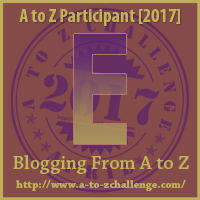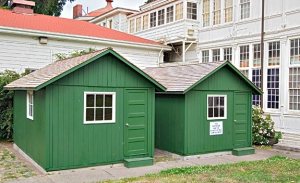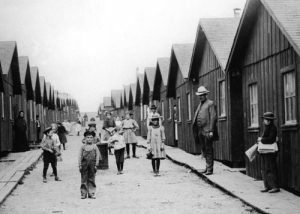 In what I refer to as my past life, I was a Department of Defense civilian employee. I worked on the Presidio of San Francisco, primarily in Public Affairs. Behind our building was the U.S. Army Museum, and behind that building were two small green huts, about 8’x8′ square. These were the last two earthquake cottages built for displaced San Franciscans after the 1906 earthquake.
In what I refer to as my past life, I was a Department of Defense civilian employee. I worked on the Presidio of San Francisco, primarily in Public Affairs. Behind our building was the U.S. Army Museum, and behind that building were two small green huts, about 8’x8′ square. These were the last two earthquake cottages built for displaced San Franciscans after the 1906 earthquake.

If you read In The Eye of The Storm or Through the Opera Glass, you will have seen references to these little buildings. Claire, Veronique, and their neighbor Maeve share one near to the U.S. Army Hospital (the building that eventually became the museum) because Claire is volunteering there in the aftermath of the disaster after her family is displaced.

The Army’s Department of Lands and Buildings built literally hundreds of these little houses in the wake of the earthquake, and also managed two tent cities: one on the Presidio and one in Golden Gate Park. The earthquake villages, which were scattered all over the city, were patrolled by military police, and the denizens were fed. Often it was just earthquake stew, which was heavy on potatoes and light on meat (I’ve had it), but it was nourishing.
After the Presidio of San Francisco was closed as a military base, the Golden Gate National Recreation Area became the new landlords. The two remaining earthquake cottages were moved to the San Francisco Zoo’s Conservation Corner.
I didn’t know about the earthquake cottages. It makes sense, though. I’m interested in the earthquake soup recipe. Even though I’m not a vegetarian, I tend to prefer less meat in my food. Do you have any idea what the ingredients are? Was it good enough to be recreated?
LikeLike
The cookbook containing the recipe lives in the archives of the Berkeley Library (I linked to it). We did a reenactment during an Army Days celebration in which the mess hall cooks recreated it. It was pretty bland, to be honest … mostly potatoes and carrots in a very blond roux with a little bit of ground meat. I’m not a big stew fan to begin with, so this didn’t do much to change my mind.
LikeLike
They are awfully cute. Earthquake stew sounds good. I love potatos.
LikeLike
They were definitely for efficiency living only!
LikeLike
First time I’m seeing these cottages. Ironically, today abodes of this size are sometimes touted as “small living” alternatives for overcrowded cities or by folks seeking alternatives to large, energy-consuming houses. How times change.
LikeLike
These were pretty much clapboard shells with a cot and a few shelves; definitely nothing like the tiny houses we see touted nowadays!
LikeLike
Very interesting. Knew about the earthquake, of course, but sadly admit I never gave much thought to where the many displaced were put. My father, now retired, worked for the DoD in DC and Virginia.
LikeLike
I’ll be sharing a little bit more earthquake history later in the series; it was an interesting and challenging time for San Francisco, to say the very least.
LikeLike
These are pretty cool. Why can’t we do this more often, given the increasing number of natural disaster we seem to be dealing with.
LikeLike
There are laws now that preclude using military labor where civilian labor could be used. During the 1906 earthquake, Maj. Gen. Frederick Funston pretty much declared martial law; he announced that the City was under the Army’s control, and he proceeded to do as much as he could to “fix it,” including giving soldiers authorization to shoot looters on sight, no questions asked, creating a fire break using dynamite and, obviously, having these little houses built.
LikeLike
Those earthquake cottages are fascinating – a forerunner to the small house movement? My autistic brother in law may love something like that – a small space (he spends most of his time at home in his bedroom) cozy and easy to care for.
LikeLike
They were definitely not built for comfort … but I can see how someone would look at them and think “I could live in this.”
Thank you for stopping by!
LikeLike
Hello, fellow A-to-Zer! I like this. I didn’t know about these earthquake cottages. It is nice to think about the two huts sitting behind the building where you worked, as if waiting politely to be noticed. Or anyway that is how I envision the scene. Thanks for this!
Melanie Atherton Allen, from Atherton’s Magic Vapour
LikeLike
What a nice thought!
We did an event called Army Days toward the latter part of my career on the Presidio, and we did a photo shoot of me in Edwardian attire (I was a historical reenactor) and a gentleman in period uniform that featured the cottages in the background. If I could have found one of those photos in time (they’re put away very safely, apparently), I would have included that. It was neat to take a step back in time with them.
Thank you for stopping by!
LikeLike
We need similar earthquake cottages. We’ve been experiencing a lot these past weeks (although as of late, I haven’t received any more incidences). Are those houses sturdy?
Mark Your Words!
LikeLike
Two of them stood the test of time but the rest did not. They were pretty bare-bones wooden construction.
LikeLike
They have to be modified then…
LikeLike
Moved?
When were they moved? I was very recently at the Presidio and saw them.
LikeLike
I guess it depends on your definition of “recently.” As of last summer (the last time I was on PSF), they were no longer there at all. The one at the zoo was moved there in 2006. The Kirkham Shacks and one other were donated to the Fifth Avenue Institute at Jack London Square for restoration in 2008. If restored cottages have since been returned to PSF, that would be great and I’d love to know about it.
LikeLike
I believe they are there behind the old post hospital.
Next time I am in S.F. I will go by and take a look.
Probably I will go after the summer as S.F. is so active until later October.
LikeLike
They used to be behind the museum (which was the first hospital), across the street from Building 38 … which is where my office was. If you get a chance to take a look, I would love it. I’ll happily approve any photo you want to share here, too. It matters to me. Thanks!
LikeLike